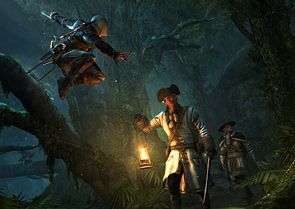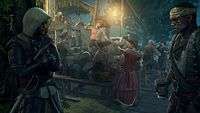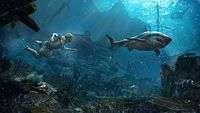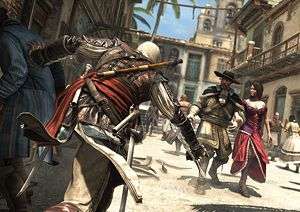Assassin’s Creed IV: Black Flag – Preview
by Ian
 There are some things that you expect every year – birthdays and Christmas inevitably roll around, the clocks go back at pretty much the same time annually, and the joy of summer gives way to the bleak, harsh winter. Almost as natural as these, now, is the release of the latest Assassin’s Creed game – a series now about to move in to its sixth main console release in as many years. Coming from the team that worked on the well-received Assassin’s Creed: Revelations, the final part of Ezio Auditore’s grand story, Black Flag puts players in the shoes of Edward Kenway, an outlaw Captain in the pirate-infested Caribbean, and the grandfather of Assassin’s Creed 3 protagonist Connor.
There are some things that you expect every year – birthdays and Christmas inevitably roll around, the clocks go back at pretty much the same time annually, and the joy of summer gives way to the bleak, harsh winter. Almost as natural as these, now, is the release of the latest Assassin’s Creed game – a series now about to move in to its sixth main console release in as many years. Coming from the team that worked on the well-received Assassin’s Creed: Revelations, the final part of Ezio Auditore’s grand story, Black Flag puts players in the shoes of Edward Kenway, an outlaw Captain in the pirate-infested Caribbean, and the grandfather of Assassin’s Creed 3 protagonist Connor.
In a first for the series, the narrative is being rewound by thirty-five years, with the story commencing in 1715. Although Black Flag is linked to AC3 by the Kenway bloodline, the feel of the game so far is very different to Connor’s tale and in the few hours that I had with the game, Edward Kenway was already a more engaging and charismatic lead than his grandson ever managed to be. Although in an interview with lead writer Darby McDevitt it was claimed that the story and character were being written before AC3 was ever released, the criticism of Connor’s rather dour personality can only have influenced that verve and style that Granddad Kenway immediately displays. In the limited portion of the game that was available, some supporting cast members were introduced who appeared to have a natural interplay with Kenway, much as the characters through the AC2 arc did with Ezio. Hopefully this will lead to a story and cast that is much easier to engage with for the player.
Coming from the team behind AC: Revelations, some welcome gameplay elements appear to have returned that had been conspicuous by their absence in AC3. Small touches such as the courtesan and mercenary groups return to aid you in remaining concealed, and the mini-map once again highlights hiding spots when being chased by guards – something that had been frustratingly omitted from AC3, leading to protracted and tedious guard fights instead of quick, assassin-like escapes.
 In a similar vein of promoting the feeling of actually being an assassin, Haytham’s eagle vision is now far more useful than ever before, with the alternate-vision mode now automatically tagging enemies, allowing them to be tracked through both the environment and on the mini-map once the mode has been deactivated. This plays in to the larger, more open-ended stealth sections, with areas of the map specifically designed with a focus on stealth and choice. The team has promised a return to the more open-ended assassinations as seen in the very first game, with players free to tackle these set pieces in whatever way they see fit – something that the improved stealth mechanics certainly aid.
In a similar vein of promoting the feeling of actually being an assassin, Haytham’s eagle vision is now far more useful than ever before, with the alternate-vision mode now automatically tagging enemies, allowing them to be tracked through both the environment and on the mini-map once the mode has been deactivated. This plays in to the larger, more open-ended stealth sections, with areas of the map specifically designed with a focus on stealth and choice. The team has promised a return to the more open-ended assassinations as seen in the very first game, with players free to tackle these set pieces in whatever way they see fit – something that the improved stealth mechanics certainly aid.
Aside from the now-familiar third-person action, AC4 also builds on the naval gameplay that was introduced in the last game. Rather than being a separate, almost bonus addition, sailing your ship is now integral to the game. Set as it is in the Caribbean during the peak time of piracy, your ability to sail a ship is paramount to success. The controls have been tightened since the voyages of the Aquila around the Eastern Shores of revolution-period America, with the Jackdaw offering more nimble movement and several new offensive options. Enemy vessels can now be disabled and boarded, rather than just destroyed, in order to acquire loot and pirate booty.
 |
 |
 |
 |
 |
 |
 |
 |
 |
Another layer is added in the form of having to acquire and maintain a crew, a mechanic that appears to replace the Assassin’s Guild aspect of the previous few games. Loot from conquered ships can be used in a crafting system that appears similar to that in AC3 in terms of mechanics but, like almost everything that was shown in the preview, this has also been tidied up and made more user friendly. Crafting can now happen anywhere, rather than just at ledger books, and the interface is far less clunky and confusing. Hunting animals also makes a return, with pelts and other animal parts also contributing towards the crafting system.
 Aside from these few changes, much of the core gameplay remains untouched. The Parkour system is largely the same as in previous installments, insofar as when it’s done right it feels fluid and fun – but too often, like his ancestors and descendents, Kenway will climb walls and run in to obstacles that the player never intended, leading to some teeth-gnashingly frustrating moments, especially when engaged in combat or an escape. It remains to be seen whether this will be tightened for the final release but, as the preview code we played was described as being 90% complete, it appears as though the same frustrations in movement that have at times plagued the series will continue in to the next-gen with AC4.
Aside from these few changes, much of the core gameplay remains untouched. The Parkour system is largely the same as in previous installments, insofar as when it’s done right it feels fluid and fun – but too often, like his ancestors and descendents, Kenway will climb walls and run in to obstacles that the player never intended, leading to some teeth-gnashingly frustrating moments, especially when engaged in combat or an escape. It remains to be seen whether this will be tightened for the final release but, as the preview code we played was described as being 90% complete, it appears as though the same frustrations in movement that have at times plagued the series will continue in to the next-gen with AC4.
Combat also remains untouched, with large groups of enemies very politely attacking one at a time, allowing players to use the parry and counter style of fighting introduced right back in the first game. Animations and kill moves are becoming increasingly flashy, but there’s absolutely nothing new here – at this point, seasoned assassins should be able to finish most fights with their eyes closed.
Speaking of next-gen, the preview code was running on PlayStation 4 dev kits, giving a glimpse in to the capabilities of the new breed of games. Graphically, the game was impressive, and was confirmed to be running at a 1080p full HD resolution while maintaining a locked 30 frames per second. In my time with the game, through a variety of locales and gameplay situations, including open, rolling oceans, and crowded sea-side towns, the frame-rate never seemed to dip, lending the game a smoothness that has been noticeably absent in the last few Assassin’s Creed games.
 Unfortunately, it appears as though current-gen releases may suffer in comparison even to previous games – when pressed, Associate Producer Sylvain Trottier stated that the team are aiming for a 720p resolution at 30 frames per second on Xbox 360 and PlayStation, but could not confirm that this would actually be achieved – certainly something to note when considering which version of the game to buy, especially when it has been confirmed that the PC version will be at least the equal of the next-gen version of the game.
Unfortunately, it appears as though current-gen releases may suffer in comparison even to previous games – when pressed, Associate Producer Sylvain Trottier stated that the team are aiming for a 720p resolution at 30 frames per second on Xbox 360 and PlayStation, but could not confirm that this would actually be achieved – certainly something to note when considering which version of the game to buy, especially when it has been confirmed that the PC version will be at least the equal of the next-gen version of the game.
It is perhaps telling that there was no opportunity to see an example of the current-gen version running – while this can be attributed to wanting to show off the advancements possible with new hardware, it is slightly concerning when coupled with a lack of confirmation on the fidelity on the current-gen hardware, especially with little over a month left before release.
 |
 |
 |
 |
 |
 |
 |
 |
 |
Overall then, the brief preview demonstrated a game series that is confident in the direction it has already taken, building as it is on the foundations of a now-yearly franchise. Adjustments appear to be slight but all for the better, mostly addressing the criticisms that had been levelled at AC3. The changes just about rescue AC4 from seeming to be just more of the same but, at the same time, the core gameplay is very similar to what has come before – the appeal of this game lies in the new, pirate-laden setting and emphasis on naval gameplay. If either of these falls short in the final version, then the worry is that there’s not enough here to really warrant another full sequel so soon after the last. The core gameplay is still enjoyable when it’s being done right, but with combat and movement untouched, it remains to be seen how much longer this formula can stay fun and hold players’ interests.
Last five articles by Ian
- Shooting Stars - Review
- Sora - Review
- Early Access - Epistory, Ironkraft, and Zombasite
- 1849 - Preview and Interview
- Diablo III: Reaper of Souls - Review
























There are no comments, yet.
Why don’t you be the first? Come on, you know you want to!